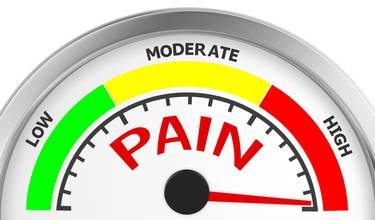Years ago, we believed that pain was rigid, but today we know that pain is changeable. If we are in pain, the way our bodies handle pain changes over time, says professor Lars Arendt-Nielsen from Center for Sensory-Motoric Interaction at Aalborg University. For a number of years, Lars Arendt-Nielsen and his colleagues have been working on developing a new method of measuring pain. The method has enabled the scientists to discover that patients with chronic pain perceive the pain to be stronger than patients who do not experience chronic pain. If a person experiences a local pain, e.g. in the back, arm, knee or the like, the body starts to become almost allergic to the pain. This means that the pain worsens over time.
Along with his colleagues at Center for Sensory-Motoric Interaction, Lars Arendt-Nielsen are among the frontrunners when it comes to pain research, and the fact that they have now discovered this new way of measuring pain, makes them unique internationally. Pain is very complex and it involves many different mechanisms. Imagine burning your finger – at first, you will experience a stinging pain and after that a burning sensation. This highlights the fact that different nerve paths create different aspects of pain.
How to measure
The new method is all about quantifying the pain. If a test subject with chronic pain is exposed to pressure, not much pressure is needed to trigger pain. The researcher maps the pain, so it looks like a temperature weather chart, on which red is very sensitive to pain and blue is less sensitive. That way, researchers are able to measure and map how much pressure to apply before triggering pain in the patient and thus where the patient is most sensitive to pain. When a patient experiences pain for a prolonged period of time, more and more areas will turn red, meaning that the pain, and the low sensitivity to it, spreads.
“With this new method, we are now able to quantify the pain and uncover why local, acute pain in some patients sometimes spreads and becomes chronic. We also discovered that the brain’s ability to block pain differs. We know that patients, whose ability to block the pain is poor, develop more chronic pain after surgery” Lars Arendt-Nielsen explains.
“The brain has a throttle and a brake, so to speak, and these block and intensify the pain. Unfortunately, this balance is sometimes off, especially in people with chronic pain. In other words, this function is crucial for keeping pain under control.”
From acute to chronic
In this way, we now know why local, acute pain in some patients may spread and become chronic. “Why some people develop chronic pain and others don’t, remains unanswered. But we do know that genetics as well as social and psychological factors are important”, Lars Arendt-Nielsen says. He underlines that the recent research results will be important when producing new analgesics for chronic pain patients. The results from the study provide an advantage because it becomes possible to assess whether a drug in development will be efficient in treating pain.
“Earlier, it was a common belief that it was only possible to alleviate chronic pain using drugs like morphine. Today we know that it is important to target the substances in the central nervous system, which aggravate the nervous system. Because of this, drugs traditionally used for treating depressions and epilepsy are often used in the battle against chronic pain today,” the professor explains.
Thus, drugs that weren’t specifically made to treat pain but other conditions are used. With our new knowledge and this new method, the big breakthrough consists of developing new drugs specifically for treating pain. An area where great things will happen in the future, “Lars Arendt-Nielsen says, and makes a reference to the development within biological pain treatment.
“Within biological pain treatment, a lot has happened in recent years. The first studies regarding the use of biological substances in the treatment of pain have already been published, and it is our hope that these new types of substances affect the pain’s development and possible the causes. That would definitely be a revolution in the area – just like the treatment of rheumatoid arthritis was improved when biological treatments were introduced. With these new treatments, we will be able to control what triggers the pain in the first place. And thus, we will be able to cut the vicious circle: The vicious circle in which the nervous system has gone into overdrive.
Sources:
http://www.dr.dk/sundhed/Sygdom/Gigt/Artikler/2010/1006100617.htm








